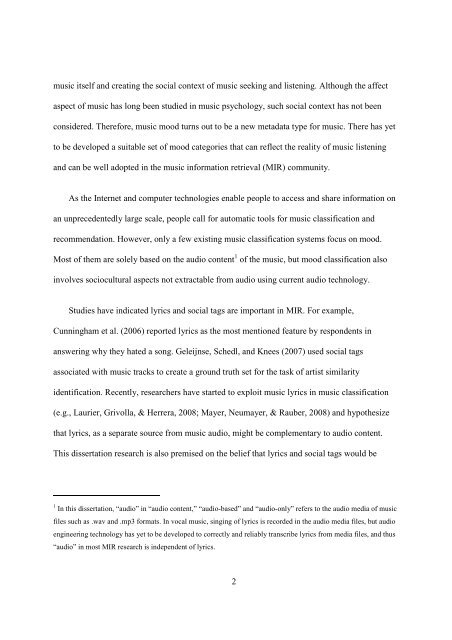improving music mood classification using lyrics, audio and social tags
improving music mood classification using lyrics, audio and social tags
improving music mood classification using lyrics, audio and social tags
You also want an ePaper? Increase the reach of your titles
YUMPU automatically turns print PDFs into web optimized ePapers that Google loves.
<strong>music</strong> itself <strong>and</strong> creating the <strong>social</strong> context of <strong>music</strong> seeking <strong>and</strong> listening. Although the affect<br />
aspect of <strong>music</strong> has long been studied in <strong>music</strong> psychology, such <strong>social</strong> context has not been<br />
considered. Therefore, <strong>music</strong> <strong>mood</strong> turns out to be a new metadata type for <strong>music</strong>. There has yet<br />
to be developed a suitable set of <strong>mood</strong> categories that can reflect the reality of <strong>music</strong> listening<br />
<strong>and</strong> can be well adopted in the <strong>music</strong> information retrieval (MIR) community.<br />
As the Internet <strong>and</strong> computer technologies enable people to access <strong>and</strong> share information on<br />
an unprecedentedly large scale, people call for automatic tools for <strong>music</strong> <strong>classification</strong> <strong>and</strong><br />
recommendation. However, only a few existing <strong>music</strong> <strong>classification</strong> systems focus on <strong>mood</strong>.<br />
Most of them are solely based on the <strong>audio</strong> content 1 of the <strong>music</strong>, but <strong>mood</strong> <strong>classification</strong> also<br />
involves sociocultural aspects not extractable from <strong>audio</strong> <strong>using</strong> current <strong>audio</strong> technology.<br />
Studies have indicated <strong>lyrics</strong> <strong>and</strong> <strong>social</strong> <strong>tags</strong> are important in MIR. For example,<br />
Cunningham et al. (2006) reported <strong>lyrics</strong> as the most mentioned feature by respondents in<br />
answering why they hated a song. Geleijnse, Schedl, <strong>and</strong> Knees (2007) used <strong>social</strong> <strong>tags</strong><br />
associated with <strong>music</strong> tracks to create a ground truth set for the task of artist similarity<br />
identification. Recently, researchers have started to exploit <strong>music</strong> <strong>lyrics</strong> in <strong>music</strong> <strong>classification</strong><br />
(e.g., Laurier, Grivolla, & Herrera, 2008; Mayer, Neumayer, & Rauber, 2008) <strong>and</strong> hypothesize<br />
that <strong>lyrics</strong>, as a separate source from <strong>music</strong> <strong>audio</strong>, might be complementary to <strong>audio</strong> content.<br />
This dissertation research is also premised on the belief that <strong>lyrics</strong> <strong>and</strong> <strong>social</strong> <strong>tags</strong> would be<br />
1 In this dissertation, “<strong>audio</strong>” in “<strong>audio</strong> content,” “<strong>audio</strong>-based” <strong>and</strong> “<strong>audio</strong>-only” refers to the <strong>audio</strong> media of <strong>music</strong><br />
files such as .wav <strong>and</strong> .mp3 formats. In vocal <strong>music</strong>, singing of <strong>lyrics</strong> is recorded in the <strong>audio</strong> media files, but <strong>audio</strong><br />
engineering technology has yet to be developed to correctly <strong>and</strong> reliably transcribe <strong>lyrics</strong> from media files, <strong>and</strong> thus<br />
“<strong>audio</strong>” in most MIR research is independent of <strong>lyrics</strong>.<br />
2
















